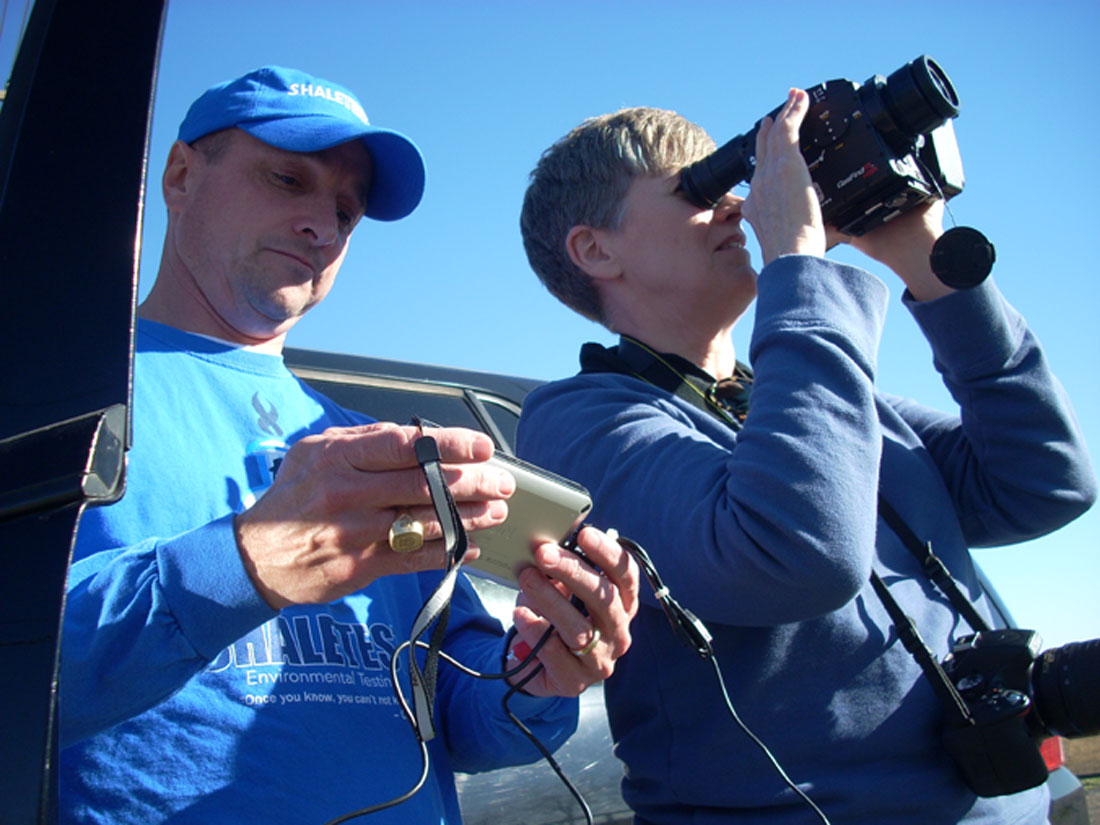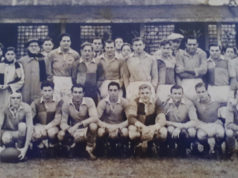It felt like being a witness to history: watching Sharon Wilson learn how to use a FLIR camera to detect otherwise-invisible streams of toxic emissions from gas-drilling facilities. Gas company executives who have fought the veteran critic of their industry, in venues from South Texas to the floor of the U.S. Congress, might think of it as more of a nightmare — like seeing Sherlock Holmes getting a stronger magnifying glass.
Wilson, the inveterate blogger and Texas representative of the Earthworks’ Oil and Gas Accountability Project, was in territory she knows well — the country roads west of Denton, where gas wells, compressor stations, injection wells, and other drilling-industry facilities sometimes seem more numerous than trees or cows. She was learning the ropes of the FLIR (forward-looking infrared) camera from another veteran, former DISH mayor Calvin Tillman, board member of the nonprofit group that owns the camera.
In a political and regulatory landscape where favorable news for drilling critics can be a rare commodity, Tillman had good tidings.
“We had a very good year,” he said of ShaleTest, the nonprofit he organized in 2010 with Tim Ruggiero. The company has received grants and donations that have enabled it to extend its reach to more states and to more communities within Texas.
Start with the camera, one of the tools that ShaleTest uses to provide low-income individuals and communities with information on potential pollution from nearby gas industry activities. Until this year, ShaleTest borrowed a camera regularly from a supporter who lives out of state. This year, thanks to an anonymous donation of about $40,000, ShaleTest got its own FLIR camera, plus a handheld tester that measures the amounts of volatile organic compounds, known as VOCs, in the air.
ShaleTest is now affiliated with Earthworks, the national advocacy group that focuses on environmental impacts of energy and mining industries. ShaleTest partnered with Earthworks to do testing and research for reports on drilling impacts in the Eagle Ford shale play in South Texas and elsewhere.
The locally based nonprofit also received a grant from Patagonia, the maker of outdoor equipment and clothing, to do air testing at Texas parks and playgrounds that are near drilling facilities.
In addition to the grants and the major donation for the camera equipment, Tillman said ShaleTest has raised more than $10,000 in donations.
Using the $11,000 Patagonia grant, Tillman said, ShaleTest has used the FLIR camera to record emissions at four green spaces — one each in Denton, Fort Worth, Mansfield, and DISH — and set up air-sampling canisters at three of them.
“It’s an ongoing thing; we’re going to do more work at those four facilities,” he said.
But ShaleTest’s reach extends far beyond Texas. Tillman and Ruggiero have traveled to Pennsylvania, where heavy drilling activity in the Marcellus Shale is affecting many communities, to do testing, help others learn how to do it, and tell their stories from the drilling-war front in Texas.
“Pennsylvania has two very heavy pockets of production, in the northeast and southwest, and we’ve done a significant amount of work up there,” Tillman said. “I go up there probably twice a year.”
One of the group’s volunteers in Pittsburgh, Pa., is working to get additional grants for ShaleTest in that region, he said.
ShaleTest has also done extensive testing in drilling-affected communities in Wyoming. If there’s one state where the drilling pollution is worse than in Texas, he said, it’s Wyoming.
Local ShaleTest veterans have also used Skype to train volunteers in New Jersey and New York in pollution data-gathering techniques.
The group has also worked under agreements with other nonprofits to gather pollution data. Tillman said neither individuals nor communities or organizations are charged any fees for the work that ShaleTest does, just expenses — when the other groups are able to pay.
A major benefit that ShaleTest is able to provide is low-cost air-testing canisters. Because they use 75 to 100 canisters a year, Tillman said, they are able to get them for far less than their usual cost of about $600 each, and they pass those savings on to the communities — and then they either train the volunteers in how to use the canisters or the ShaleTest workers set up the canisters themselves. After a certain time period, the samples thus captured are shipped off to be tested for a long list of chemicals. About 60 locations in Pennsylvania have used canisters provided by ShaleTest.
Tillman said the group is working on a proposal that would enable ShaleTest to put all the data on air and water conditions into an interactive map online, “so that you could go county by county in Texas or Wyoming or Pennsylvania, wherever we have data from, and click on the county and pull up all the data we’ve taken there.”
On Sunday, Wilson was getting the hang of the FLIR camera and the VOC tester pretty well.
At one compressor station on FM 455 in Wise County, Tillman stopped the SUV and began filming. He let out a chuckle as the camera revealed strong streams of emissions coming from the tanks. Wilson looked through the camera’s viewfinder.
“Oh my God, and we’re standing right in it,” she said. The emissions were invisible without the camera, but they certainly could be smelled by anyone standing downwind of the tanks. The VOC meter showed high readings, up to 4.2 parts per million. Wilson immediately called in a report to state regulators but was unimpressed at their response later that day and the next.
Tillman said that in areas such as South Texas and parts of Wyoming, where there is a lot of what is called sour gas, “it’s horrible getting in and taking those samples.”
“We really are pretty thrilled” at what ShaleTest is accomplishing, he said. “And really, the only limitation is ourselves” — that is, those involved in the ShaleTest work. “All of us have other jobs; that’s been the biggest limitation” on what the group can do.













Thanks ever so much, for all of your hard work on those Shale Projects!
I do hope you will be, testing in the JOSHUA,TEXAS areas! Because of the high concentrations of the tanks, in this area!
Other family members, as well as, my own family, lived near- by, some of those Tanks and water way areas. I lost a brother-in-law some 3 years ago, to Cancer. His wife has had surgery for Cancer. And, my husband has been in treatment for over 2.5 years for Cancer, himself. My granddaughter lost 7 weeks of school, while attending High School in Godley,Texas. And, is still sick after 2 years. And, has missed the last 9 weeks of school, now, during her Senior year. I, personally believe, that families living in Joshua, and those surrounding areas like; Fort Worth and Godley, are at risk from Toxins!…So, it’s Great to know, we the Citizens here in South Texas, finally have some caring watchdogs, looking out for these Communities, located in these areas.
God bless you all for the time you all spend, for the betterment of others!
Thank you all ! Sincerely, Alice J Stack Mullahy
4.2 ppb sounds really low. According to the EPA website, “No standards have been set for VOCs in non-industrial settings. OSHA has adopted a Permissible Exposure Level of .75ppm, and an action level of .5ppm. HUD has established a level of .4ppm for mobile homes. Based upon current information, it is advisable to mitigate formaldehyde that is present at levels higher than .1ppm.” 4.2ppb is equivalent to .0042ppm.
It was ppm not ppb.
Thanks for the correction; I thought that sounded at odds with the rest of the article.
We’re growing as an organization as well; Shaletest just recently named John Fenton Director Northwest and Kari Matsko Director Marcellus. Your continued support if our efforts is greatly appreciated.
We’re growing as an organization as well; Shaletest just recently named John Fenton Director Northwest and Kari Matsko Director Marcellus. Your continued support of our efforts is greatly appreciated.